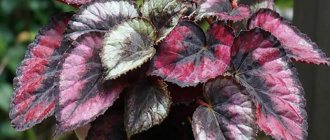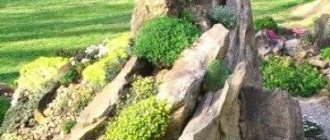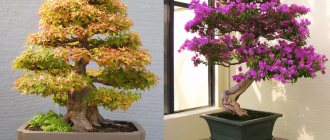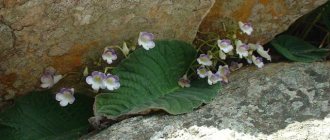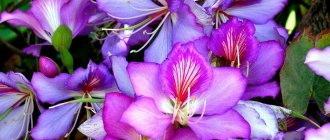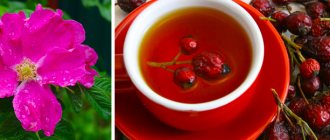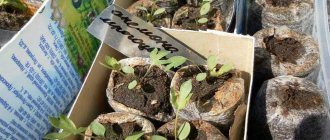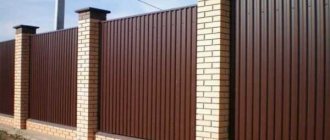Botanical description
Tuberous perennial with self-forming stems and asymmetrical leaves. The height of the stem is 20-60 cm, and the length of the leaves is 10-20 cm. Begonia Pendula is notable for its long (30-40 cm, and in some varieties up to 1 m) hanging shoots. For this reason it is also called pendulous begonia. It has unisexual, monoecious flowers of bright colors with a diameter of about 5 cm. Some varieties have larger flowers.
Not all amateur gardeners are ready for ordinary flowers to bloom on purchased terry begonias.
If this happened to you, don’t be upset! These flowers are female. Take care of your plant, monitor watering, and soon wonderful double male flowers will bloom on your begonia. We grow at home
In this section we will talk about how to grow pendulous begonia on your own.
Popular varieties
Garden begonia 'Illumination Apricot'
Some varieties of hanging begonias are combined into series. For example:
- Illumination – plants of this series grow quickly, branch well and bloom luxuriantly. Shoots up to 30 cm hanging. Double flowers with a diameter of 5 to 7 cm. The series is presented in four colors. The most popular variety in the series can be safely called Illumination apricot.
- Sensation is a dwarf cascading begonia with very large double flowers up to 10-12 cm in diameter. The series is particularly resistant to bad weather conditions.
- The variety series Opium, or Odorata, are compact bushes with shoots up to 25 cm and large double flowers up to 10 cm. These begonias are distinguished by the presence of a delicate aroma. Varieties: Begonia Odorata Fragrant Red, Odorata Pink Delight, Opium Red, Opium White
Begonia "Champagne"
And also Cascade Apricot Gold, Double Dark Red and the mesmerizing beauty of Cascade Picotee Florence.
"Cascade Picotee Florence"
Choosing landing conditions
The right time for planting is February or March . Such timing is due to the fact that it has a long growing season. If you are late with planting and care, then it will only be able to bloom by the end of summer.
The tubers you buy for planting must be healthy : medium-sized, dense, round. Try to feel them before purchasing, because the appearance of the future plant depends on them.
Prepare your pots in advance! Containers for planting should be small but wide. Drainage holes are a must! At the very bottom of the pot there should be broken shards and drainage. The soil needs to be porous, breathable, and nutritious.
Planting begonia
Before planting, keep the tubers in moist, light warmth. That is, “plant” the lower part of the tuber on a damp, warm cloth or other material and leave it in the light. As soon as small white roots appear from below, the tubers are ready for planting.
Pre-moisten the soil in the pot (but do not flood it, a good spray from a spray bottle is enough). Plant the tubers on it with the part where the roots appeared. Cover the space around the tubers with soil, but not to the top. The top of the tubers should remain open until sprouts appear.
Planted begonias should be watered carefully. Water should not be allowed to get on the tuber itself.
Transfer
The flower is planted in its permanent place of growth in May. Considering that the surface layer of soil always dries out quickly, the tubers need to be “drowned” a little into the ground. Literally 1-2 cm. The land itself must be fertile.
For this plant, not only the composition, but also the temperature of the soil matters. At low temperatures, the roots cannot absorb moisture from the ground, which threatens the begonia with drying out. The optimal soil temperature for it is 18–20ºС.
If you plant one tuber per pot, then its diameter should not exceed 13-15 cm. Also, you should not choose pots that are too deep, because Begonia has a more superficial root system. The deeper the container, the faster the lower layers of soil will acidify in it, and begonia does not like this. But very low pots will not work either. Don't forget that there should be a place for drainage at the bottom of the container to remove excess water. The material of the pot does not matter, but it is important that there are drainage holes (5-6 pieces) at the bottom.
According to the lunar calendar
Taking into account the position of the Moon helps to correctly calculate the timing of landings. Traditionally, sowing is not done during the full or new moon. The best option is to choose a period when the star is in an active growth phase.
Hanging begonias look great on hanging flowerpots; the lunar calendar will tell you when to sow it in the spring to get good seedlings by May or June for planting:
- in February: 7, 13, 14, 22, 23, 24, 28;
- schedule for March: 3, 4, 17, 18, 22, 23, 26, 27, 30, 31;
- sowing dates for April: 8, 9, 18, 19, 23, 24, 25, 26, 28.
The sowing schedule assumes that the grower independently calculates the time required to prepare the planting material. If the seeds are collected from last year's flowering, they should be soaked in advance, discarded and treated against possible infection.
The soil is prepared separately: it is disinfected, calcined, and moistened. An integrated approach will ensure maximum germination and allow you to count on receiving luxurious flowers.
Caring for begonia
The plant does not tolerate waterlogging. Bottom watering is recommended for it: directly into the tray or along the edge of the container, avoiding contact with the tubers. In summer, during the period of constant flowering, you should water abundantly, but remembering that everything is good in moderation. In winter there is no need to stop watering , but do it carefully and little by little.
The ideal place for growing is in diffuse sun or light partial shade. The flower does not like direct sunlight due to the risk of burns on the juicy green leaves. And the lack of light threatens with stretching of shoots and lack of flowering.
This specimen likes to grow at a temperature of 19ºC, but it will easily withstand 25 and 12ºC. At home, begonia should be protected from elevated temperatures in winter. Provide it with fresh air and ventilation - this strengthens it. Read about caring for begonia tubers in winter here.
To support begonia during the period of prolonged flowering, it needs to be fed every few weeks. The fertilizer should be liquid, complex and it is good if it is intended specifically for begonias. Be careful with nitrogenous fertilizers - they provoke leaf growth and there will be no energy left for flowering.
Care
To obtain good results in the process of growing hanging begonias, you should pay attention to the following conditions:
- The optimal temperature and humidity conditions in the room should be at +18-22°C, humidity 50-70%.
- Between 11 a.m. and 3 p.m. to evening, begonias need sunlight.
- Moderate moisture, do not flood the plant with water.
- From the beginning of spring to autumn it is important to feed the flower. Especially during the flowering period, use fertilizers high in potassium and phosphorus. Twice a year you can feed with organic fertilizers.
- As necessary, you should pick off dried flowers, loosen the soil, spray, remove dust from the foliage, and inspect the plant for pests.
As can be seen from the above, propagating and growing ampelous begonia yourself is not so difficult . You just need to put in a little effort, and the ever-blooming beauty will always look elegant and festive. Bloom for the joy of you and those around you.
If you find an error, please select a piece of text and press Ctrl+Enter.
Bloom
Due to its long flowering period, this plant is called ever-blooming. From May to November, ampelous begonia is strewn with flowers. Male flowers are larger, more elegant, double, while female flowers are simple, consisting of only 2-5 petals. One flower lasts about ten days, and new ones immediately appear to replace it.
The dormant period lasts about 3.5 months - from November to early March. At this time, there is no need to disturb her (but remember about very unhurried, careful watering).
History of appearance
The beauty was first found by the clergyman Charles Plumier in the 17th century. He was a member of the expedition to the Antilles. In total, the monk found about 6 representatives of the amazing plant, naming it in honor of his friend and governor of the island Michel Begon, who organized this research.
Since the discovery of the first species, begonia has been subject to continuous hybridization and selection. Today, a huge number of varieties and hybrid forms are known, most of which were bred in Belgium. In specialized stores you can often find “Begonia Terry Mix”.
Reproduction
Ampelous begonia propagates by seeds, cuttings, and tubers.
The most labor-intensive propagation method is growing ampelous begonia from seeds. They are really tiny: 50,000 per gram of raw seed. They are sown on loose soil without sprinkling a layer of soil on top. The top is covered with film to retain moisture and heat inside. All this time, constant watering is required so that the seedlings do not dry out. After 3 months, the plant is planted in a pot.
Cuttings are the most affordable way to grow begonia. Place 10-centimeter cuttings of overwintered begonia in water and wait until sprouts appear. Then plant the cuttings in pots, 5 cuttings per pot.
For tuberous propagation, the cut parts with 2-3 buds are sprinkled with charcoal powder. Another option is colloidal sulfur. So they are dried, and then planted in the usual way.
Suitable soil
For indoor growing, you must use a soilless mixture. The composition simplifies the entry of nutrients from the substrate to the roots. Most soilless mixes consist of peat moss mixed with perlite or vermiculite. Using peat often causes some discomfort. Before use, you should dilute the component with boiling water, softening the material. Should be used after cooling.
It is contraindicated to use standard compounds alone, for example, humus or leaf soil. The collection does not allow water to pass through well, which leads to disease damage to the crop.
The exemplary soil composition for growing begonias: sand, peat and black soil in equal proportions, also two parts of leaf soil.
Pests and diseases
Ampelous begonia is not a painful plant, but it can also have troubles. This is gray rot - rot on the leaves and shoots of a flower; powdery mildew - white coating on leaves; Bacterial spot is a disease of the back side of begonia leaves. Spraying with special solutions will help against these misfortunes.
Among the insects that cause harm are the soft scale insects, aphids, whiteflies and others. Spraying is also suitable to combat them (select a product based on the parasite), and in some cases it may be necessary to remove part of the plant.
Try growing ampelous begonia next summer and you will be delighted with this flower. Tender or passionate - it will lift your mood in any case.
One of the tuberous begonias is the Elatior variety, which you can read about on our website.
Photo
Below you can see photos of how to care for Begonia at home:


